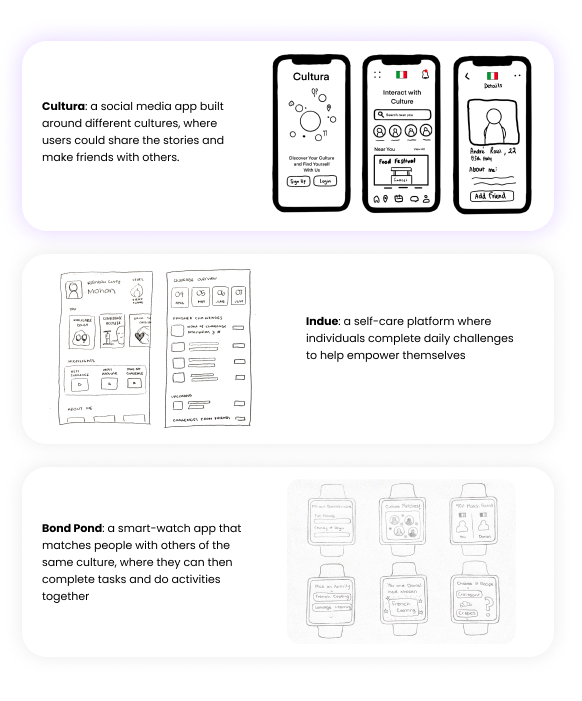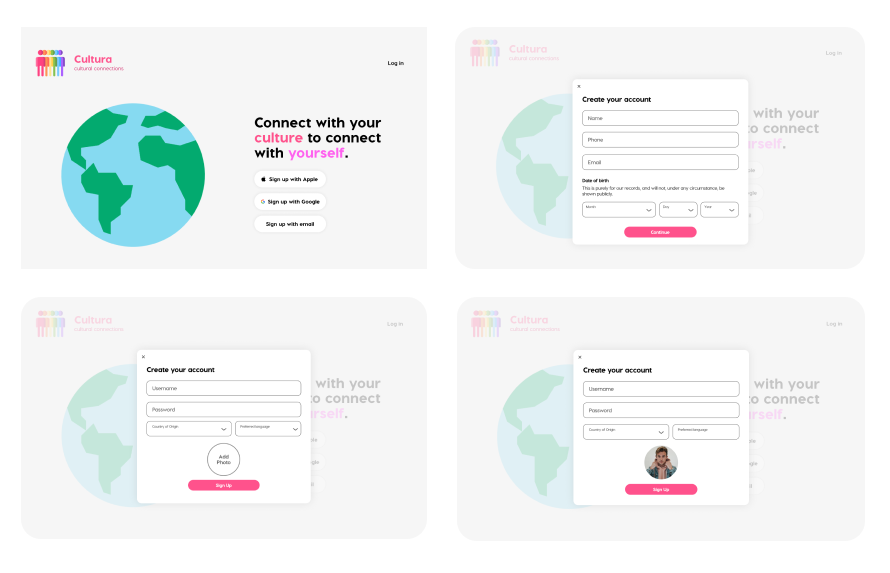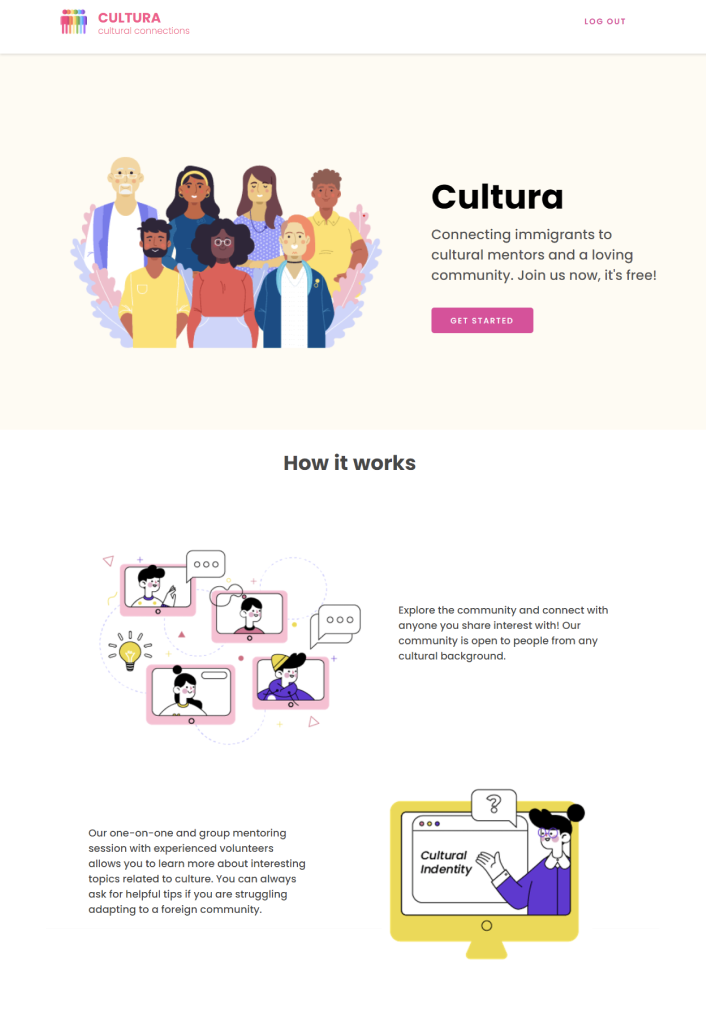Digital Designer
Cultura: Designing for Immigrants
Empowering Young Adult Immigrants Through Mentorship and Community Building
MY ROLE
User Interface Designer, User Experience Researcher, App Developer
MY RESPONSIBILITY
- Conduct background research, user testing, and analyse research insights
- Create sketches to communicate concepts, design moodboards, and high-fidelity wireframes
- Develop high-fidelity prototype of the product via Bubble.io
TOOLS
Figma, Bubble.io, Adobe Illustrator
PROJECT OVERVIEW
Cultura is all-in-one platform that helps young adult immigrants to create a helpful community build around mentorship services and connect groups.
The web app is a group project for a Product Design studio class. The target audience that we chose was the marginalized community, specifically young adult immigrants. The process that we went through for this project is divided into four stages:
1. Background Research
2. User Testing with Mid-Fidelity Prototype
3. Concept Refinement
4. Final High-Fidelity Prototype
Background Research
Immigrants are one of the underrepresented groups in Australia that have a common issue of losing their identity and/or sense of belonging. According to the Australian Bureau of Statistics, by 2020, there were 7.6 million migrants living in Australia, which makes up 29.8% of Australia’s population. Despite its growing population of migrants, these individuals are still an underrepresented group in Australia as one’s social perception and development in a foreign country still repeat the emotional concern of feeling like an outcast, which is frequently ignored.
Cultural identity is an important part of an individual’s personal and social development in a foreign country, and it needs to be protected to prevent issues, which in extreme cases, can lead to ethnocide, segregation and apartheid from the host society (Bhugra, 2005). It is something that our society should not look away from but instead help empower these individuals to feel accepted and comfortable with their living situations. The target market for this project is teenagers and young adult immigrants, who are most prone to feeling alienated or alone in a foreign country (Goodenow, 1993). These groups are forced quickly to assimilate, causing one to drop or lose their culture of origin and take on the dominant culture.
From our interviews and secondary research, we found that the need of our target users are:
1. Feeling valued and heard
2. Feeling comfortable within a community
3. Having trustful companions who share the same experiences, helping them embrace their cultural identity and have a sense of belonging.
Ideation
In our Ideation stage, we came up with three initial concepts: Cultura, Indue, and Bond Pond. Using the decision matrix to deliberate which idea to go with, our group decided to choose Cultura. The app is not just suitable for the target market, but also has the potential to reach other demographic such as the elderly.

User Testing
When developing our iterations, we always had an objective in the back of our minds: to test our product and see how well it aligns with user wants/needs. We focused on experimenting with different aesthetics and user interface to create a mid-fidelity prototype that best suits our user needs. Besides the aesthetics, we developed a series of questions to ask, as well as surverys for our testers to fill out. We did this to ensure that we have an adequete amount of feedback that we could use to further iterate on our designs.
Design Moodboards
Before we did our user testing, we decided to make moodboards to each design iteration with different styles. The moodboard is particullarly helpful in making sure that everyone is on the same page before the design process begins. By creating these moodboards, we were able to determine how to make a good web app design with different styles to test with our users.
User Testing
Cultura’s orginal goal was to to empower adolescent and young adult immigrants to feel more confident by helping them find a community that shares something in common, which leads them to embrace themselves and their personal cultural identity. However there were a lot of questions about our product differentiation and value proposition. What made our concept unique? How does it stand out amongst our competitors? We realised that our value proposition was not strong and unique enough.
To combat this, we decided to reframe the idea by creating a clear and unique value proposition.
Based on the insights that we received from interviews with five participants, we created a new value proposition that better suits our user needs. Our new value proposition is :
"For new young adult immigrants who want to share their knowledge on cultural differences, our innovative web app provides helpful tips through mentoring services and connect groups."

Final Solution
We opted to use Bubble.io when actually developing our concept. Despite our minimal coding experience, we wanted to find a way to make a proper working prototype. Ultimately, we settled on developing the main functions of our web app, whilst creating the visuals of other screens in the same app, but without the functionality.
This can be seen in our messaging screen, where we did not fully program the messaging functionality. It had to be compromised so that we had time to complete the video calling feature and the discussions page. Since those are the main focuses of our concept, we wanted to prioritise developing those to the best of our ability. In saying that, we did still incorporate the messaging screens, and users can still type messages, however, the functions are not all there.
Our first stage went into developing the basic layout of each screen and creating functions so it worked well. The second stage focused on the aesthetic stylings of popups and menus, as well as improving connectivity between inputs. Overall, the process of building the final prototype may have had its challenges, and we may have had to sacrifice some functionality due to our own abilities, but we have created a final product that we are proud of.
Documentation
Full documentation of our process can be found here:
1. Background research, market research, initial concept development: click here.
2. Iteration and testing using think aloud protocol and interviews: click here.
Let's Work Together!
Don't hesitate to contact me if you have any inquires! I'm best reached through Linked In or email.
